bran
Full Member
Posts: 227 
|
Post by bran on Nov 19, 2020 6:09:17 GMT -5
The odd thing about Conan "property" is that, due strange circumstances (weird attempts to present his work as part of other novels, pastiches, Marvel and Dark Horse adaptations and new stories, and now a public domain) - it became a mythology.
While Tolkien for example wanted to create the mythology (and by raw content - he did, LOR/Hobbit is very mythology-alike), but due to very protective stance of his estate - the only thing in print are the original books (and close adaptations, when it comes to other media) - it really does not live like a mythology. Mythology (as opposed to, say, creator-owner work) is living and breathing thing. Personally I think that's the right stance (not to allow any deviation from the original) in 99.9% cases -- unless the author explicitly wanted to create the mythology. Strangest thing. Myself, I am not a big fan of mythologies (way too much crappy work you have to weed out), adaptations are usually fine. Now, A Witch Shell be Born (Glenat adaptation) was originally solicited for 2021, if I am not mistaken. I've got the original book (it's one of his best) and Marvel and DH adaptations, and I can't wait for the 3rd one. It'll be fun to compare 3 adaptations, against each other, and with the original in this thread. |
|
bran
Full Member
Posts: 227 
|
Post by bran on Nov 22, 2020 1:16:41 GMT -5
Le peuple du cercle noir (The People of the Black Circle) ... Case in point, the opening sequence here is a battle scene that is not included in the original yarn. I suppose it is meant to establish Conan as a powerful warrior, and to provide information about a later plot point; but both are superfluous, since Conan will be established as a powerful warrior later on (and how!), and the later plot point does not need to be introduced early. Why the scene is detrimental is that it puts Conan right in the centre of things (once again), making his world look that much smaller. Absolutely. Following the story from tight 3rd person perspective (and sometimes 1st person) from several characters, is one of REH's masterstrokes. [Andrzej Sapkowski (Witcher) and George Martin (Game of Thrones) are using the same technique in their novels big time.] You don't have to follow Conan in every-single-frame. Pastiche writers just can not shake it. Added battle from the beginning must have been exhausted, and it appears that Conan goes on, climbs high walls, fights city guards and Yasmina's body guards, right after it! Granted, we can rationalize that there are days that passed by, but it just comes out that way when you read. Completely unnecessary addition. Anyway, I love how Conan constantly short-circuits "the protocol". When he is a king, he goes out of his way to do things that give headache to his security and the generals, in Black Colossus he is a general but leads the army like a king (and pisses off some of the other generals in the process), and here in The People of the Black Circle he goes on and kidnaps important political figure -- in person (that of course spawns butterfly effect and additionally complicates already complicated geo-political situation; to the point that you can barely follow; he will use that situation to his advantage later on in the story). |
|
|
|
Post by wildfire2099 on Nov 25, 2020 21:42:56 GMT -5
Got 'Queen of the Black Coast' from an ebay seller (both nifty variants) It was quite interesting to see Conan in a cartoony, almost Manga style. That panel when Conan finds everyone dead was pretty crazy, especially with the lighter style. It was really impactful. I do still like the Roy Thomas version of Belit the best, but this was a pretty good version too.
|
|
bran
Full Member
Posts: 227 
|
Post by bran on Nov 26, 2020 13:34:16 GMT -5
People of the Black Circle is drawn in style that is... er.. odd combination of manga-ish and super-hero styles (say 90s flavor). So for example when Conan jumps, that jump is way above human standards, sometimes he takes two or more opponents with a single stroke (with ease) and so on. Yet, unlike in super-hero comics there is blood splashing all over the place. So battles look like a total carnage. (I suppose the exaggeration was originally created in coded comics to overcompensate for the lack of blood and broken limbs, and other unpleasant things, yet to maintain bad-ass look on the surface. Now when you have both.. this is what you end up with.) Artist Park however draws facial expressions quite well and architecture/buildings is spot on (exotic and beautiful, familiar yet not from this Earth's history). Very much in vain of Barry Smith. Overall I am satisfied with it, it's nice to have different takes and no in-house style. ---- When opponent calls Conan "Cimmerian!", I am sure it was supposed to be "localized" version of "Roman!" from Gladiator, but yeah it doesn't work. If Conan is wearing, say, Aqualonian armor, "Aqualonian!" would work all right. |
|
|
|
Post by wildfire2099 on Nov 26, 2020 22:31:01 GMT -5
I agree.. while I'm sure over time some going to be better than others, with Conan I definitely enjoy the unique styles. I'm just really happy I can get them... wasn't sure that was going to be the case for a while there.
|
|
|
|
Post by Roquefort Raider on Nov 29, 2020 15:01:47 GMT -5
La maison aux trois bandits ( Rogues in the House). 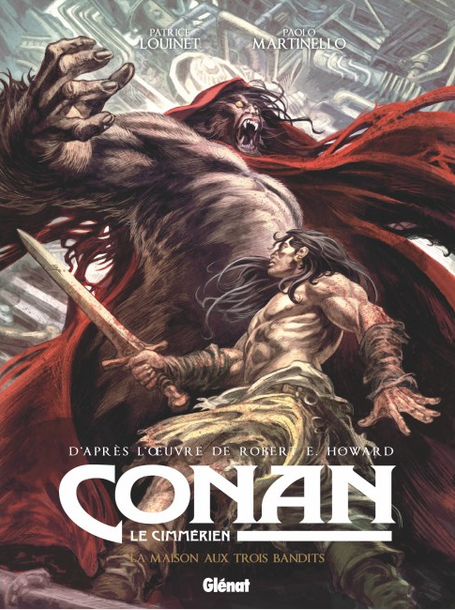 Adapted from Robert E. Howard' work by Patrice Louinet (script) and Paolo Martinello (art). An excerpt can be found on Glénat’s website. As with the previous volumes, this book contains the title story, a short analysis of Howard’s original tale by Louinet, and a portfolio by several artists (including Gary Gianni and Mark Schultz). All in all it’s a worthy addition to Glénat’s Conan series, although it does not reach the very high bar set by The Frost Giant’s Daughter or Red Nails. Patrice Louinet is well-known in modern Howardian scholarship circles, particularly since he got a Ph.D. thesis in Howardian studies. I wondered how he would handle the script of a comic-book adaptation, and expected him to stick scrupulously to Howard’s text (a bit like Kurt Busiek did in the Dark Horse series). While Louinet does indeed stick pretty closely to the original story, he takes a few liberties here and there. More power to him, since this series is supposed to present different visions of the Cimmerian’s adventures, but when such changes are made I prefer them to enhance the story; this is not the case here. The art by Martinello is the most distinct feature of this book. As far as mood goes it evokes the art of Michael Zulli, and gives us a Hyborian world that looks like a Renaissance Venice (or Moorish Granada, in some scenes). I quite like this change of scenery; we were treated to a similar one in an old Savage Sword of Conan issue ( #185, drawn by Dale Eaglesham). Some images also reminded me of Rafael Kayanan, who was something of a fan-favourite in the early '90s. 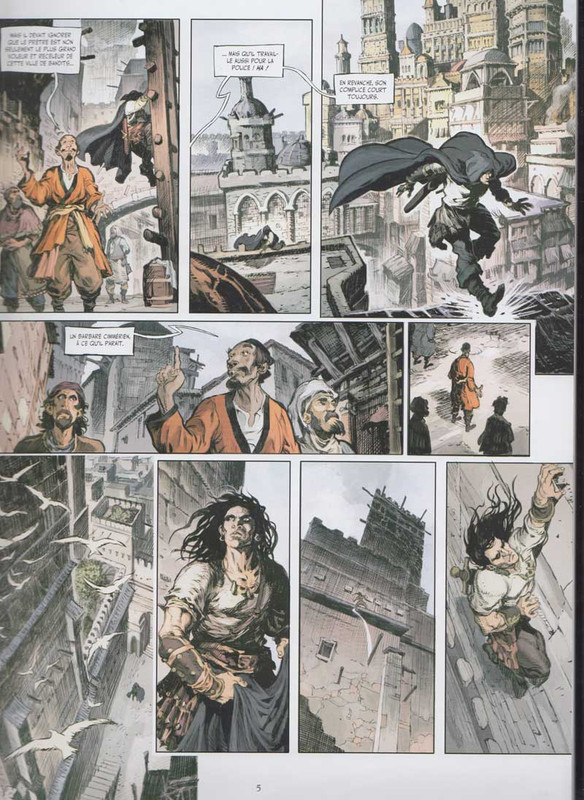 Martinello is also very good when it comes to creative panel arrangement.  I have a problem with one extra scene thrown in by the writer. In the original story, Robert Howard sets the table for the whole drama in a matter of five paragraphs: Murilo, a nobleman in need of an assassin, goes to the city gaol where a certain Cimmerian is awaiting execution. Our man Conan has earlier murdered a priest who was also double-dealing fence, a priest who had betrayed Conan’s partner in crime to the police. Conan, after avenging his friend, had been betrayed in turn by a greedy lover. No more need be explained about the situation, and the story could start right there. Here, We are shown that Conan’s lover betrayed him not to the police, but to Murilo himself, and that Conan’s arrest in a tavern (where he kills a captain of the city guard and is stopped only thanks to his being quite drunk) is something of a rigged event. The rationale for this added scene, apparently, is that we readers need to be told how Murilo first heard about Conan and then decided that a man condemned for killing a priest would not flinch at killing another (since Murilo’s intended victim is also a priest). That is completely unnecessary, as far as I am concerned, and by linking more characters and events than necessary, it hurts our suspension of disbelief. As most fans-turned-writers should learn, not everything needs to be connected! Murilo needs an assassin, and so he goes to the city jail because he heard, like everyone else in the city, that the infamous killer of a certain priest has been captured. There’s no requirement for him to have any other link to Conan; furthermore, the prostitute who sells Conan has no real reason to go see a nobleman instead of the actual city guard. That, to me, is like making Helen Gaius Mohiam the mother of the Lady Jessica in the awful Dune prequels. Not impossible, but unnecessary and harmful to the plausibility of the tale. Ah, well. Author's privilege. Rogues in the House has a certain famous scene, the one in which Conan dumps his faithless lover into a cesspool. In Howard’s story, the girl is said to be wearing a night shift; when Barry Smith first drew the scene (in Conan the barbarian #11) he had her draped in a bed sheet; when Cary Nord drew the scene in the Dark Horse series the girl was stark naked; here she is wearing only a loincloth. I think this is a rare case of a character being systematically dressed more scantily in the comics than in the prose story! (The following page contains nudity. Viewer's discretion is advised). {Spoiler}  Once upon a time, I really enjoyed Easter eggs in my comics; things like Terry Austin drawing Popeye in the background of a scene made me chuckle heartily. Now, well... getting older and crankier, I find such things distracting and even a little annoying. In one scene, here, we have a jab at Red Sonja that I could have done without. An ungainly redhead in a bar, practicing her trade, promises Conan that no one gets bored with Sonia (not with a y, not with a J, but with a chainmail bikini). 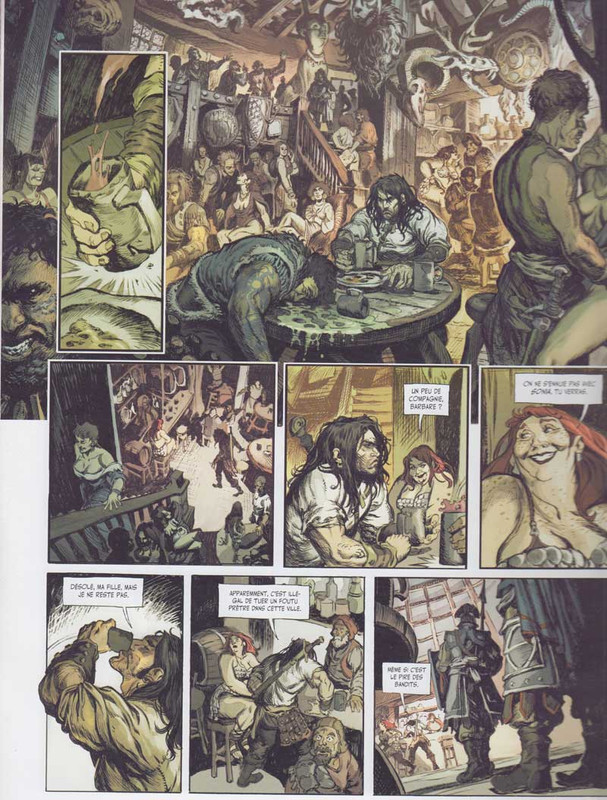 Okay, I get it, Conan purists think that Red Sonja is a silly concept, especially when she wears that stupid thing. I agree about the impracticality of it, and would much rather see Sonja wear her leather armour from the graphic novel Conan and the Ravagers Out of Time. But I’d also much rather have such opinions voiced in interviews or articles than in actual stories. (Karl Edward Wagner was guilty of the same thing in his novel The Road of Kings). We also have what looks like a homage to the famous “Wolverine in a storm drain” image drawn by John Byrne in X-Men #132. 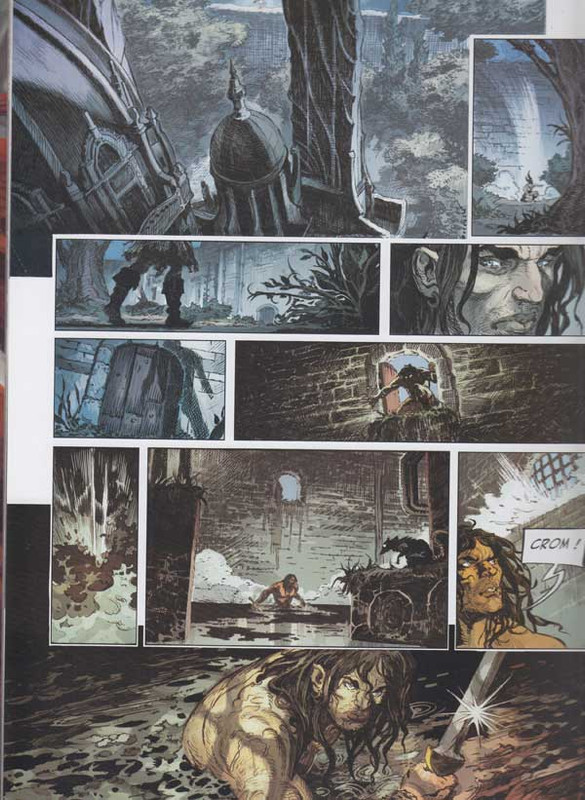  It might be a coincidence, of course. But I would expect most modern comic-book artists to be familiar with that image. These quibbles aside, the story is engaging and the art remains beautiful throughout. The pacing might be a little off sometimes, but not enough to be a problem. I liked how the bad guy showed some genuine affection toward his murderous ape-like servant, whom he raised from infancy. That was a worthwhile addition by Louinet. The pin-ups at the end include this lovely one by Mark Schultz, who also illustrated the Del Rey book The Coming of Conan the Cimmerian. I absolutely adore Schultz’s Conan, and it would be an absolute treat to have the man do a full comic. 
The next title in the series will be The God in the Bowl. Once again it will be a tall order, as Barry Smith's original adaptations of most of these tales remain my absolute favourites.
|
|
|
|
Post by wildfire2099 on Dec 2, 2020 20:47:29 GMT -5
That's exciting! That's my 2nd favorite one after Frost Giant's daughter (which is coming out in the states this month).
Can't wait!
|
|
bran
Full Member
Posts: 227 
|
Post by bran on Dec 3, 2020 16:12:06 GMT -5
... The pin-ups at the end include this lovely one by Mark Schultz, who also illustrated the Del Rey book The Coming of Conan the Cimmerian. I absolutely adores Schultz’s Conan, and it would be an absolute treat to have the man do a full comic. 
Now that's some proper shadowing. It's like "old" school. Well there is nothing really old about it, it's just - artists in the 70s/80s had to do it rich like that, since coloring was separated from art, and there was no "shadowing with colors" back then. That was pure magic: 
|
|
|
|
Post by thwhtguardian on Dec 11, 2020 15:19:11 GMT -5
That's exciting! That's my 2nd favorite one after Frost Giant's daughter (which is coming out in the states this month). Can't wait! It's out now and man was it ever worth the wait! This wasn't just a great adaptation of Howard's work but an absolutely stunning example of the pure storytelling power of the comic book medium. I'm totally over the moon with the quality of this comic. |
|
|
|
Post by wildfire2099 on Dec 11, 2020 16:26:54 GMT -5
Looks great!
Frost Giant's Daughter #1 came out today... loved it! Excellent art style for the story.
|
|
|
|
Post by Deleted on Dec 28, 2020 20:33:45 GMT -5
Just picked up the first volume of the Ablaze hc...  that collects Queen of the Black Coast and Red Nails. I am hoping to get to reading it this weekend. -M |
|
|
|
Post by Deleted on Jan 11, 2021 11:06:02 GMT -5
Finished that collection of the Cimmerian, and have mixed feelings on it. My reaction is still percolating, but here's what I wrote on Goodreads...
-M
|
|
|
|
Post by Deleted on Jan 11, 2021 13:08:45 GMT -5
I think I can articulate a little bit of why I disliked this adaptation of Queen of the Black Coast so much. But to do so, I have to discuss a couple of things about the original story that really highlighted Howard's chops as a writer, things that gave the story more depth and layered meanings, and how those things were absolutely stripped away from the adaptation by omitting them, giving me the impression the adapters had no clue in their understanding of Howard as a writer in general and the story in particular.
Those two things can be filtered down to two phrases-a scarlet cloak and cursed hyenas.
First the scarlet cloak. It seems a throwaway thing, a simple visual detail that the writer and artist omitted from the story. Artistic license being what it is, no big deal, right? Except in Howard's story it is not an empty detail, it is a throughline carried through the entire story that is a visual symbol of Conan's state of being and his relationship with Belit. As he escapes from Argos on to the Argus, Conan wears the scarlet cloak and it flows wild and free behind him. Howard takes time and effort to describe the cloak. It flies free as the young care-free Conan rides free, a visual symbol of his state of being. Once he is aboard the Tigress, the scarlet cloak becomes the symbol of Conan's bond and relationship with Belit. It is the cloak she lies upon leading up to their coupling, it is the cloak she wraps herself in when Conan leaves to patrol the ship and prowl in the night. It is a part of her as Conan has become a part of her and a symbol of what Conan has given of himself to her. No longer flowing wild and free, he is tied a part of himself to her. The maturation of the wild youth into his first mature love. And then, in the ruins of the city, it is the scarlet cloak that Conan lies Belit's body in when he takes her down from the mast, it becomes her funeral shroud as Conan sets her off in the Tigress to burn with her in her funeral pyre. He is losing the part of himself he gave to her, it died with her and remains with her in death. The process of loss and mourning that comes when a life's love is lost. Conan is not the same man as he watches the Tigress burn that he was when he brazenly leaped aboard the Argus at the beginning of the story. The scarlet cloak is a visual cue that tells the story in a simple, symbolic way, that should play well in a visual medium like comics. But in this adaptation-no cloak. He's not wearing it in the opening scene. It's not there when Conan and Belit mate, and not there when her body burns aboard the Tigress. In this adaptation it becomes a symbol not of Conan's growth and change as a character through his interaction with Belit, but a symbol of what is missing from this story-any emotional depth of thematic underpinnings. In Howard's original. this is a display of a subtle skill that Howard possessed as a writer, he wrote pulp action yarns, but layered them with theme and emotional depth (something missing from the deCamp/Carter edits and pastiches, and even from a lot of the Marvel adaptations/stories). For a series that bills itself as being true to the spirit of Howard, it is an utter failure as they ignore what Howard was saying in the story gleaning only the pulp trappings and the salacious content of the pulp.
And then the cursed hyenas. Not only is the fight with the hyenas a great action sequence in the original story, one that helps build the tension towards the climatic encounter with the winged ape (which in the adaptation looks nothing like an ape or even simian at all), the hyenas themselves are a payoff for the set up in a conversation Belit and Conan had about the afterlife, and add a crucial element to Belit's post-death appearance to save Conan in the story's climax. Aboard the Tigress, Belit and Conan discuss their beliefs about the afterlife, with Conan essentially saying he cares little for what the afterlife will be, all he wants is a full life and clean death and if he has that, what will be, will be. It is at the climax of this conversation that Belit makes her promise to him that even in death her love will bring her back to him if he is in need. Later, when Conan is in the grips of the black lotus, he learns the history of these cursed hyenas. They were not beasts, but men who fought the winged ape and were defeated, but denied a clean death and passage to the afterlife. They were cursed for eternity to wear the shapes of beasts and an existence of servitude to their demonic ape slave master. To a superstitious Cimmerian, a barbarian, this is a thing of existential dread, a fate far worse than any death. And it is a vision that stays with Conan and haunts him through the story. As soon as he awakes from the lotus-induced stupor, his question is why was he spared, why did the beast who left tracks coming to him not kill him? Later, as he finds the corpses of the Tigress crew and Belit's body hanging from the mast, he again wonders why he has been left for last. What fate does the winged ape have in store for him? He is haunted by the memory of the proto-Stygians-cum-hyenas fate. Is that what is in store for him? He will fight to the death rather than be denied a clean death and that cursed end. And then as he sits upon the pyramid, bow ready and the hyenas come, Conan does what he always does, steels himself against what he faces, overcomes his dread, and takes on the threat head on. It is what makes Conan who he is. And as he kills the hyenas he faces down that dread, seeking his clean death at the very least, abandoning everything else in his savage fury until he is reduced to tearing the beasts apart by hand-better to die than wind up like them. And then they are all dead, and he is bloodied and weary. There now human corpses litter the battlefield. In giving them true death, he has freed them and allowed them to enter the afterlife. But his battle is not over, for now the true horror arrives, their slave-master, the one who cursed them and now faces Conan, who is already worn from his struggle. And the clever foe gets the better of him, and he is trapped, at the mercy of this winged ape, pinned beneath the fallen stones. He still struggles seeking his clean death, but fearful of what the beast will do, fearful of that fate worse than death, and it is in that moment of need that Belit appears. She not only saves him from death, she saves his humanity, allowing him to escape the stones that pin him and face the beast in final combat to live or to die cleanly (of course Conan wins and lives). Belit did not defeat the ape. She allowed Conan to recover so he could face the beast and be true to himself to live or die by his own efforts not to be at the mercy of the winged ape and the potential curse that could rob him of his death and afterlife. And where in the story are the hyenas and this important thematic underpinning of the story? Not there. At all. The scene was cut to give extra pages to a sex scene between Belit and Conan that looks like it was taken shot for shot out of any of hundreds of generic porn videos complete with the guy choking out the girl as he takes her; a scene that is only implied not depicted in the original story.
So these two omissions serve to rob the story of its thematic underpinnings, its layers of meaning and the strengths that Howard brings to the table as a writer. It leaves the story devoid of meaning and power. What it leaves is a bad soft-core porn comic with a couple of gory action sequences tacked on. Just a terrible adaptation as far as I am concerned.
I did quite like the Red Nails adaptation though. It captured the feel and salaciousness of the Conan pulp stories without losing all the Howardian elements that make the Conan stories more than just that.
-M
|
|
bran
Full Member
Posts: 227 
|
Post by bran on Jan 30, 2021 21:45:01 GMT -5
and Frost Giant's Daughter #2 is out, so far so good. Quite good.
May be slightly off topic, but I have to recommend Mark Russell's take on Red Sonja (Dynamite series), there are 23 issues so far, and there will be one more (plus Killing of Red Sonja 5 issue mini-series, takes place in between issues 12 and 13). I expected something close to this style and level of story telling from Marvel/Disney for Conan, but no - all we got was good old "one-man band, on the road". You know the drill: Conan in every single frame, he arrives, encounters the wizard or a witch, defeats the witch and on and on it goes; awesome Hyborian world exist in form of cardboard cutouts only (mostly throughout names of cities and kingdoms).
Russell, he creates on a dime new characters, local customs, micro-geography matters (location changes are frequent, roads and bridges and distances are very relevant), there is geo-politics, strategy, dynasties, alliances, betrayals etc etc. Good sense of humor as well - for example on Hyrkanian court there is a position of Tongue of Fire LOL. Tongue of Fire's sole responsibility is to tell the ruler the truth no matter how ugly or uncomfortable it may be. :-)
BTW, they resolved bikini issue quite elegantly just by adding other peaces of clothes on top of it, and by frequent changes in her wardrobe (after all she is not a man to wear one outfit weeks on end...). Don't get me wrong, nothing wrong with a bikini - in 20th/21st century story that takes place on the beach!
|
|
|
|
Post by Roquefort Raider on Mar 21, 2021 11:23:54 GMT -5
Le dieu dans le sarcophage (The God in the Bowl)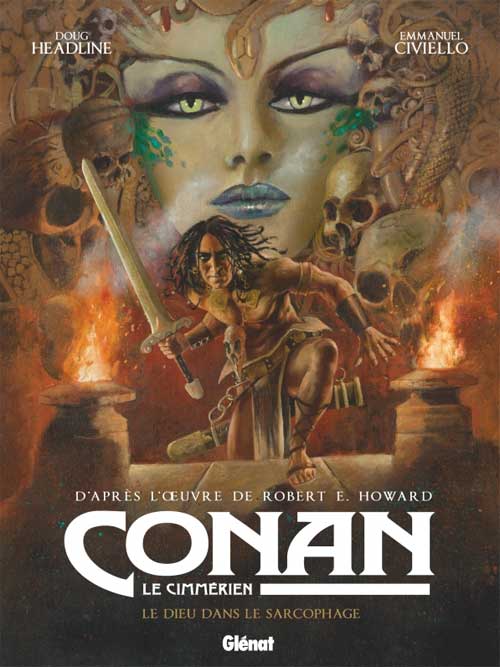 Adapted from Robert E. Howard’s story by Doug Headline (script) and Emmanuel Civiello (art). Doug Headline is the pen name of Jean Manchette, a French writer, journalist, film director and publisher. His publishing house Zenda translated such books as Watchmen and V for Vendetta for the French-speaking public. Emmanuel Civiello is a French artist with several series on his résumé. An excerpt can be found here, on Glénat’s site. The French title has been changed from the one originally given to it in the ‘70s, “ Le dieu dans L’urne” (which means “the God in the Urn”, and is closer to the original title than the new one, “ the God in the sarcophagus”. “ Le dieu dans le bol”, which would be the literal translation of “ The God in the Bowl”, is unfortunately not an option as it would sound absolutely ridiculous in French... the first idea that would come to mind is that of a god in a toilet bowl). Why the change from "urn" to "sarcophagus"? Well, there’s this sort of campaign in certain Howardian circles that tries to erase any trace of L. Sprague de Camp’s influence. I suppose that when the story was first translated, it carried the stain of the man’s editing, and that a new title was therefore required to mark this as adapting the REAL Howard story. But that's just speculation. Maybe it was a creative choice when the tale was re-translated a few years ago. The God in the Bowl is one of the five best books in the Glénat series in my opinion. It sticks pretty closely to the prose tale, and it looks beautiful. Both in terms of script and artwork, it doesn’t have the feel of a book produced by Conan fans (even if the writer, at least, is obviously familiar with the character since he translated the novelization of the recent Conan movie); it looks like a serious adaptation done by talented outsiders, sort of like what you'd get if an independent filmmaker was tackling a pop culture icon. As such, there are no annoying Easter eggs nor distracting fan service, and no "superheroic" feel; we get a straight adaptation that doesn’t look like your typical Conan book. The Cimmerian himself looks pretty barbaric. Not like a bodybuilder, but lean and wiry and obviously very strong. He wears dreadlocks and assorted ornaments; a bird skull as a pendant, and a large ring through one nostril (a first, I think). 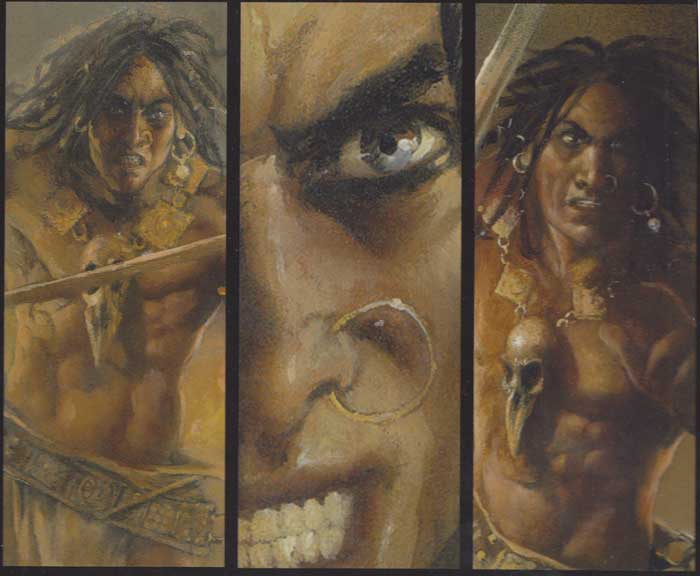 Civiello’s painted art is lush and generous, very moody and sometimes evoking the art of Bill Sienkiewicz. 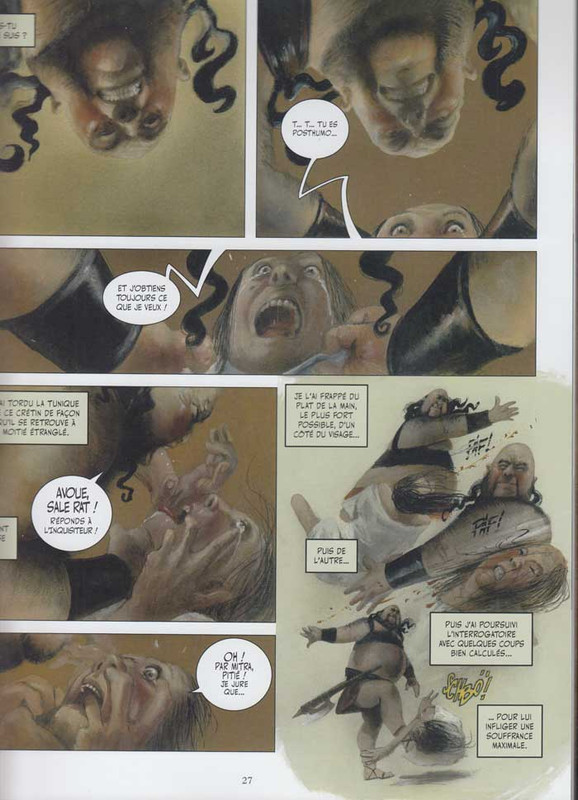 The entire story is set in a thick-walled museum at night, and the first term that comes to mind when describing the scenery is “dimly lit”. That adds a lot to the tale’s spooky atmosphere involving old gods emerging from their sarcophagus to murder people. Civiello prefers to suggest and hint at things rather than show them clearly; this is an excellent choice here, and it reflects the ambiguity in Howard’s prose (especially for the big revelation at the end). One thing that Civiello gets very right is that the bowl in which the story's monster is hidden at first is big enough to contain it! Other adaptations had rather smaller containers.  When it comes to the story’s antagonist, a huge serpent with the face of a god, Civiello follows the path chosen by Barry Smith back in Conan the barbarian #7. Howard described the face of the creature as possessing a “ …cold classic beauty(…) whose like he had never seen among the sons of men. Neither weakness nor mercy nor cruelty nor kindness, nor any other human emotion was in those features. They might have been the marble mask of a god, carved by a master hand, except for the unmistakable life in them -life cold and strange, such as the Cimmerian had never known and could never understand”. 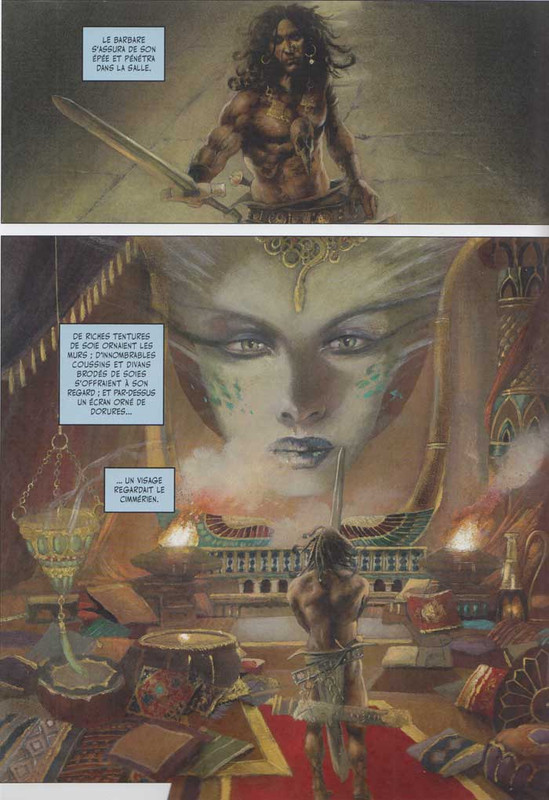 Barry Smith replaced the hair of the creature by snakes, as if it were some good-looking Medusa, a truly inspired idea. 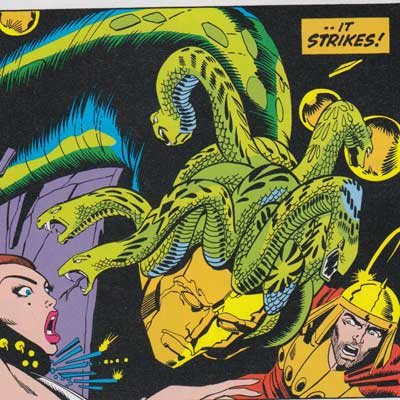 Perhaps to distinguish their version from Marvel’s, Busiek and Nord had emphasized the alienness of the face rather than its godliness : 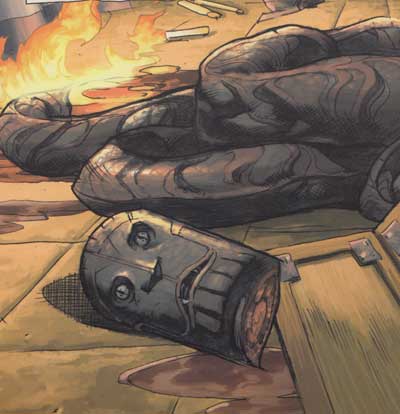 Civiello didn’t go so far as to use the ophidian hair, but he did pay tribute to it by making the head’s locks sort of snake-like. (So maybe there WAS an Easter egg in there, after all! It’s just not as distracting as a silly red Sonja spoof). 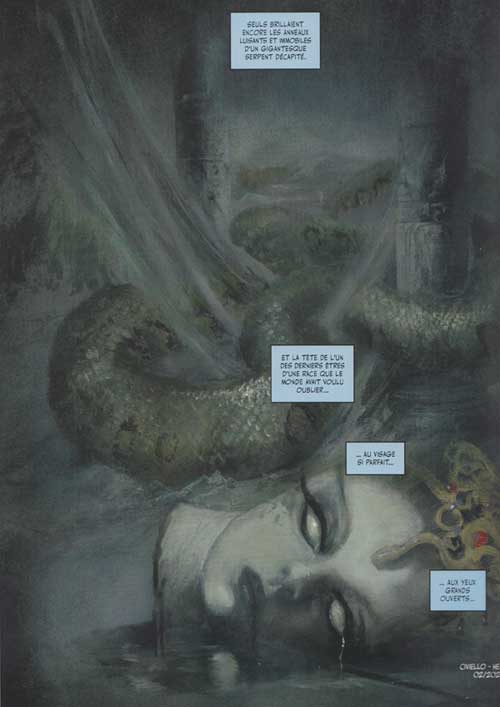 The depiction of Thoth-Amon (seen in only one image, as in both the Marvel and Dark Horse previous adaptations) is closer to the one found in the latter. I do not know if it is an actual homage or just a new version inspired by Egyptian designs. (I would have welcomed something completely new, myself). 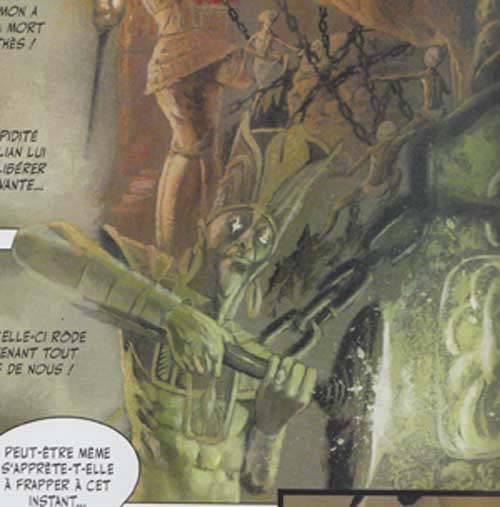 Scriptwise, Headline makes good use of Conan’s unfamiliarity with civilization (he is still very young), and Civiello renders well the puzzlement in Conan’s eyes when he faces the strange way law is maintained in a city.  The story relies on several viewpoints throughout; that of Conan, of a night watchman, of a police officer and so on. That probably helps new readers, since for such a short story Howard used a LOT of named characters! Several things caught my attention : the god Set, which in Conan's tales is the snake-god of the Stygians, is here represented as the Egyptian god Seth (who's more of a donkey/jackal/aardvark) even if the text does describe him, a few pages later, as a snake. But if gods aren’t allowed to have many forms, then who is? 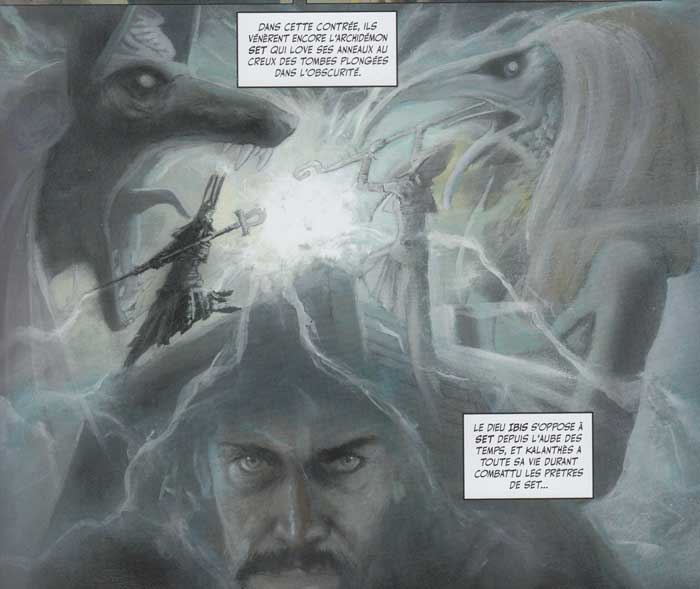 Mention is made of the “diadem of the giant kings” in the tale; the story of these giant kings serve as the book’s opening pages. The material adapted here is from Howard’s essay “ The Hyborian Age”, something that always makes me happy. A handful of pin-ups by several artists can also be found in the back pages, as well as a short article by Patrice Louinet. I learned therein that The God in the Bowl may have been partially inspired by a news article relating how a black man had been unjustly treated by the police, something that had angered Howard. (The man was terribly racist, according to his letters to different other writers, but he could not stand injustice... especially at the hand of the authorities). Howard may also have borrowed several names to Plutarch’s Parallel Lives for this story, a case that Louinet presents convincingly. Excellent addition to a series that has known as many clunkers as successes up to now. Recommended!
|
|